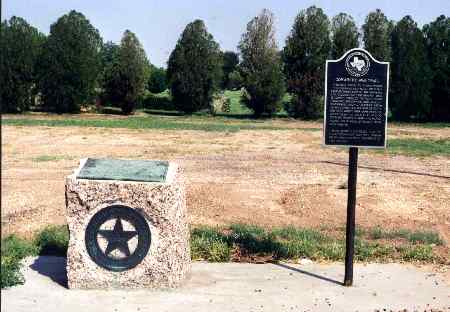

An official Texas Historical Marker commemorates a Comanche War Trail that came through Odessa, passing near the cemetery on East Highway 80.
Beginning in 1723, thundering hordes of angry Comanche warriors followed numerous trails that zig-zagged across the Plains. These merged into a mile- wide thoroughfare into Mexico-a bloody road to plunder. They often reached as far as Zacateas, Mexico and, on occasion, even as far down as the Yucatan Peninsula.
A majestic figure with strong, sharp features, the Comanche had a dignified manner. He wore colorful costumes of beaded and fringed buckskin. Quick mobility and a fierce, dominating spirit were keys to the Comanche's strength. The skillful thieves revelled in large scale raids - so regular that Mexicans called it "Comanche Moon" when the Indians came to steal women and children for slaves, as well as horses, cattle and mules.
The Comanches owned great herds of horses they called the "god dog." Individual wealth was measured in the number of horses owned. They were splendid horsemen and experts in racing and other mounted games.
The mounted tribe abandoned fixed dwellings and invented the teepee, a portable dwelling, and the "travois," an A-shaped drag which hauled the teepee cover of buffalo hides and other gear.
Great herds of buffalo numbering into the millions roamed the Plains. Tribesmen worked out cunning methods by which they could kill enough buffalo to supply the tribe with meat and clothing. This was a tribal effort - it was a grave crime for any warrior to hunt alone and frighten the herd. After the hunt, the women began their work skinning and cutting up the carcasses. The tongue and hump were the choice parts. The meat was cut and "jerked" by pounding fat and wild berries into the meat which was stored in containers of skin or membrane. This was an excellent concentrated and portable food for warriors on the move.
The Indian had an instinct for finding water. He dug into shallow springs and followed buffalo tracks to their water-filled wallows.
The proud and stately Comanches refused to co-exist with other tribes in the area who threatened their livelihood. They drove the Wichitas and Caddoes east and the Apaches west until the Mighty Comanche was Lord of the LI ano Estacado.
During 1849, an estimated 2,000 Comanches roamed the Permian Basin. They took pride in defending their hunting ground against the invasion of the "white eyes," as they encircled wagon trains of settlers and '49ers headed for the gold fields of California. Eagle feather war bonnets blew in the breeze as huge bands galloped on a trail of terror. They collected scalps of hapless pioneers and invented unique, cruel torture for captives - sometimes skinning them alive or staking them with rawhide strips to bake in the hot sun.
A warrior's prestige in the tribe depended upon his performance in war. His war paint symbolized past achievements and was supposed to protect him in battle. Each one carried a "coup stick" with which he touched a fallen enemy and shouted "A-he!" - meaning he was the victor. The warrior who struck the coup stick most often earned many battle honors, adding to his esteem with his people.
In 1876, Col. William Shafter's soldiers forced the Comanches into government reservations.
The Comanche left his mark in the area - flint arrowheads, pottery and artifacts, pictographs and burial sites.

A BARBED, BRISTLING FLYING WEDGE -THE COMANCHES-RODE INTO 18TH CENTURY TEXAS, DRIVING THE WICHITAS AND CADDOES EAST, THE APACHES WEST, BECOMING LORDS OF THE SOUTH PLAINS. HARASSED THE SPANISH AND ANGLO- AMERICANS ALONG FRONTIER FROM CORPUS CHRISTI ON THE GULF UP TO THE RED RIVER. WROTE THEIR NAME IN BLOOD CLEAR DOWN TO ZACATECAS, MEXICO. CAPTURED WOMEN, CHILDREN AND HORSES ALONG THEIR ROAD OF BLOOD, TEARS AND AGONY.
MANY ROAD CONVERGED INTO THE GREAT COMANCHE WAR TRAIL, WHICH PASSED ABOUT 20 MILES SOUTHEAST OF THIS MARKER.

Located at Memorial Garden On Service Road East Highway 80.
Courtesy: Author; John Ben Shepperd & Wanda Snodgrass
Tim O'Reilly Illustrator.
Exchange Club Publication, July, 1981.
ODESSA 100; Read this book today!